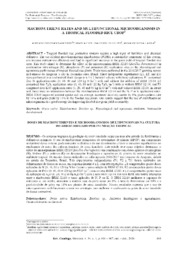Macronutrient rates and multifunctional microorganisms in a tropical flooded rice crop.
Macronutrient rates and multifunctional microorganisms in a tropical flooded rice crop.
Author(s): NASCENTE, A. S.; FILIPPI, M. C. C. de; LANNA, A. C.
Summary: Tropical flooded rice production systems require a high input of fertilizers and chemical defensive. The use of plant growth-promoting rhizobacteria (PGPR), a sustainable component of this system, can increase nutrient-use efficiency and lead to significant increases in the grain yield of tropical flooded rice crop. This study aimed to determine the effect of the microorganism BRM 32110 (Bacillus thuringiensis) in combination with nitrogen (N), phosphorus (P) and potassium (K) application rates on the physiological and agronomic performance of tropical flooded rice plants. Trials were performed in the 2016/2017 growing season in Formoso do Araguaia, a city in Tocantins state, Brazil. Three independent experiments (E1, E2, and E3) were performed in a randomized block design in a 4 x 2 factorial scheme with three replications. E1 comprised four N application rates (0, 40, 80 and 120 kg N ha-1) with and without the addition of BRM 32110, E2 comprised four P2O5 application rates (0, 40, 80 and 120 kg P2O5 ha-1) with or without BRM 32110, and E3 comprised four K2O application rates (0, 20, 40 and 60 kg K2O ha-1) with and without BRM 32110. In fertile soil, there were no interactions between the rhizobacterium BRM 32110 and the N, P or K application rates. BRM 32110 improved nutrient uptake and, on average, increased shoot dry matter by 8%, photosynthesis rate by 14% and grain yield by 11% in the flooded rice plants. Our results suggest that the use of multifunctional microorganisms is a good strategy for improving flooded rice grain yield sustainably.
Publication year: 2020
Types of publication: Journal article
Unit: Embrapa Rice & Beans
Observation
Some of Embrapa's publications are published as ePub files. To read them, use or download one of the following free software options to your computer or mobile device. Android: Google Play Books; IOS: iBooks; Windows and Linux: Calibre.
Access other publications
Access the Agricultural Research Database (BDPA) to consult Embrapa's full library collection and records.
Visit Embrapa Bookstore to purchase books and other publications sold by Embrapa.

